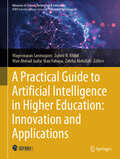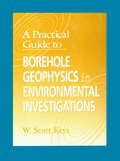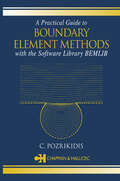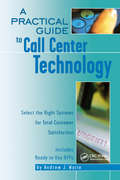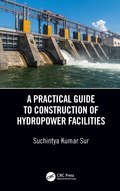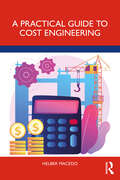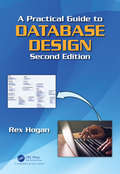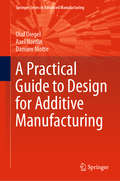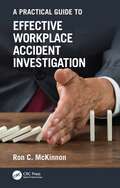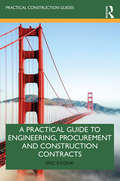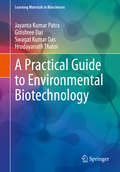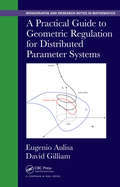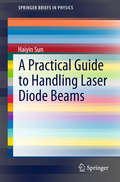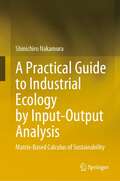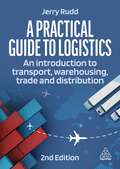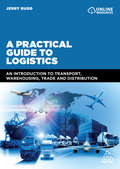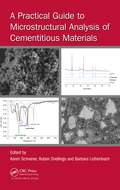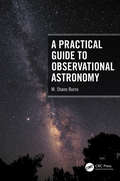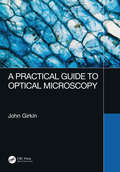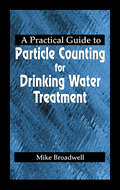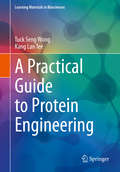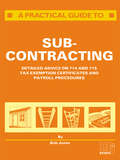- Table View
- List View
A Practical Guide to Artificial Intelligence in Higher Education: Innovation and Applications (Advances in Science, Technology & Innovation)
by Mageswaran Sanmugam Zuheir N. Khlaif Wan Ahmad Jaafar Wan Yahaya Zaleha AbdullahThis book explains how educators can use artificial intelligence in education to enhance student engagement and improve learning outcomes by sharing best practices for using AI to enhance learning quality and foster sustainable teaching. This book covers various topics related to the use of AI in education, from designing activities to using AI in teaching to using AI in assessment by following the ethical considerations of using AI in teaching. The book not only discusses the related topics to using AI in education, but also presents best practices of using AI in teaching and learning from different countries and provides best practices of ethical considerations based on lives experiences of the authors. Furthermore, the book introduces the teaching methods of integrating AI in teaching and learning. Therefore, this book offers essential information and a practical guide to using AI in education.
A Practical Guide to Borehole Geophysics in Environmental Investigations
by W. Scott KeysBorehole geophysics is frequently applied in hydrogeological environmental investigations where, for example, sites must be evaluated to determine the distribution of contaminants. It is a cost-effective method for obtaining information during several phases of such investigations. Written by one of world's leading experts in the field, A Practical Guide to Borehole Geophysics in Environmental Investigations explains the basic principles of the many tools and techniques used in borehole logging projects. Applications are presented in terms of broad project objectives, providing a hands-on guide to geophysical logging programs, including specific examples of how to obtain and interpret data that meet particular hydrogeologic objectives.
A Practical Guide to Boundary Element Methods with the Software Library BEMLIB
by C. PozrikidisThe boundary-element method is a powerful numerical technique for solving partial differential equations encountered in applied mathematics, science, and engineering. The strength of the method derives from its ability to solve with notable efficiency problems in domains with complex and possibly evolving geometry where traditional methods can be d
A Practical Guide to CRM: Building More Profitable Customer Relationships
by Janice ReynoldsIn today's global economy the customer has more and better choices than ever before, bringing on one of the biggest challenges the business community faces today - customer loyalty and retention. To thrive in today's customer-driven economy a company need
A Practical Guide to Call Center Technology: Select the Right Systems for Total Customer Satisfaction
by Andrew WaiteGet the most out of ACDs (automatic call distributors) and other complex systems in order to boost customer satisfaction and increase sales Includes three ready to use RFPs (request for proposals) for buying an ACD, computer telephony system, or recording
A Practical Guide to Construction of Hydropower Facilities
by Suchintya Kumar SurThis book deals with the narratives of water to watt, which includes elementary conceptual design, modern planning, scheduling and monitoring systems, and extensive pre- and post-investigations pertaining to hydropower facilities. It also includes explorations to ensure aspects of dam safety evaluation, effective contract management, specialized construction management techniques, and preferred material and equipment handling systems. Special emphasis is placed upon health, safety, environmental, and risk management concepts. The book discusses a standard QA/QC system to measure and assure quality and an environmental impact assessment to reach the set target in the stipulated timeline within the approved budget. Key Features: Offers comprehensive coverage of hydro-structures and practical coverage from an industry perspective Helps readers understand complexity involved in large-scale interdisciplinary projects Provides good insights on building procedures, precautions, and project management Includes project planning, construction management and hydropower technology, QA/QC, HSE, and statutory requirements Illustrates how to integrate good constructability/buildability into good design for the best monetary value
A Practical Guide to Cost Engineering
by Helber MacedoA Practical Guide to Cost Engineering aims to show you how to work as a cost engineer out in the real world.Written by an experienced cost engineer and training program developer, this book introduces the practical side of cost management (cost estimation, cost reduction, and cost control) through real cases and realistic examples from a diverse range of engineering-based projects. With examples from nuclear, oil and gas, and renewable energy sectors, the book introduces and demonstrates the activities of the cost engineer throughout a project life cycle. The content is divided into logical sections covering basic concepts, cost estimation, cost control, economic feasibility, sustainability, and more, and the chapters are packed full of features such as definitions, formulas, exercises, and examples. The focus is on providing a practical approach where the reader can first understand a concept and then apply it using an Excel tool developed by the author which allows the reader to simulate different scenarios and results.The simple approach focusing on essential information backed up by practical scenarios presented in this book allows cost engineers and related professionals to execute and understand their activities, develop their professional skills, and even develop in-house training programs. A Practical Guide to Cost Engineering is accompanied by online resources, accessible via the Routledge Resource Centre wesbite.
A Practical Guide to Database Design (Second Edition)
by Rex HoganFully updated and expanded from the previous edition, A Practical Guide to Database Design, Second Edition, is intended for those involved in the design or development of a database system or application. It begins by focusing on how to create a logical data model where data is stored "where it belongs." Next, data usage is reviewed to transform the logical model into a physical data model that will satisfy user performance requirements. Finally, it describes how to use various software tools to create user interfaces to review and update data in a database. Organized into 11 chapters, the book begins with an overview of the functionality of database management systems and how they guarantee the accuracy and availability of data. It then describes how to define and normalize data requirements to create a logical data model, then map them into an initial solution for a physical database. The book next presents how to use an industry-leading data modeling tool to define and manage logical and physical data models. After that, it describes how to implement a physical database using either Microsoft Access or SQL Server and how to use Microsoft Access to create windows interfaces to query or update data in tables. The last part of the book reviews software tools and explores the design and implementation of a database using as an example a much more complex data environment for a University. The book ends with a description of how to use PHP to build a web-based interface to review and update data in a database.
A Practical Guide to Design for Additive Manufacturing (Springer Series in Advanced Manufacturing)
by Olaf Diegel Axel Nordin Damien MotteThis book provides a wealth of practical guidance on how to design parts to gain the maximum benefit from what additive manufacturing (AM) can offer. It begins by describing the main AM technologies and their respective advantages and disadvantages. It then examines strategic considerations in the context of designing for additive manufacturing (DfAM), such as designing to avoid anisotropy, designing to minimize print time, and post-processing, before discussing the economics of AM. The following chapters dive deeper into computational tools for design analysis and the optimization of AM parts, part consolidation, and tooling applications. They are followed by an in-depth chapter on designing for polymer AM and applicable design guidelines, and a chapter on designing for metal AM and its corresponding design guidelines. These chapters also address health and safety, certification and quality aspects. A dedicated chapter covers the multiple post-processing methods for AM, offering the reader practical guidance on how to get their parts from the AM machine into a shape that is ready to use. The book’s final chapter outlines future applications of AM. The main benefit of the book is its highly practical approach: it provides directly applicable, “hands-on” information and insights to help readers adopt AM in their industry
A Practical Guide to Effective Workplace Accident Investigation
by Ron C. McKinnonThis book explains how accidents and high potential near-miss incidents are caused, and how to eliminate recurrences by effective accident investigation methods. It shows how to conduct an immediate and root cause analysis so that remedial measures can be taken to prevent a recurrence of similar events. The book shows how to apply the Logical Sequence Accident Investigation Method in the case studies presented. The book: Provides a practical guide to accident causes, investigation and prevention. Explains immediate and root causes in detail. Gives a number of problem-solving methods for the accident investigator to use. Introduces the Logical Sequence Accident Investigation Method. Provides a practical accident investigation evaluation system. The book discusses important topics including hazard identification and risk assessment, workplace health and safety, accident causation and prevention theories, the updated accident domino sequence, as well as safety management system standards and controls. The text is primarily written for professionals and graduate students in the fields of occupational health and safety, ergonomics and human factors engineering.
A Practical Guide to Engineering, Procurement and Construction Contracts (Practical Construction Guides)
by Eric EgginkThis book is a step-by-step practical guide on how to achieve successful projects in EPC/turnkey contracting and construction. Mapping out the shape of a project, the book spells out where things often go wrong, where and why disputes arise, and how to avoid conflicts. It is a key reference point for all involved in the contract, making it attractive to legal practitioners, construction industry professionals, and government officials involved with these projects.
A Practical Guide to Environmental Biotechnology (Learning Materials in Biosciences)
by Jayanta Kumar Patra Gitishree Das Swagat Kumar Das Hrudayanath ThatoiThis textbook provides practical guidelines on conducting experiments across the entire spectrum of environmental biotechnology. It opens with general information on laboratory safety, rules and regulations, as well as a description of various equipment commonly used in environmental laboratories. It then discusses in detail the major experiments in basic and advanced environmental studies, including the analysis of water and soil samples; the isolation, culture, and biochemical characterization of microbes; and plant tissue culture techniques and nutrient analyses. Each chapter features detailed method sections and easy-to-follow protocols, and offers guidance on calculations and formulas, as well as illustrative flow charts to assist with troubleshooting for each experiment. Given its scope, the book is an invaluable aid for laboratory researchers studying environmental biotechnology, and a rich source of information and advice for advanced undergraduates and graduates in the fields of environmental science and biotechnology.
A Practical Guide to Geometric Regulation for Distributed Parameter Systems (Chapman & Hall/CRC Monographs and Research Notes in Mathematics)
by Eugenio Aulisa David GilliamA Practical Guide to Geometric Regulation for Distributed Parameter Systems provides an introduction to geometric control design methodologies for asymptotic tracking and disturbance rejection of infinite-dimensional systems. The book also introduces several new control algorithms inspired by geometric invariance and asymptotic attraction for a wid
A Practical Guide to Handling Laser Diode Beams (SpringerBriefs in Physics)
by Haiyin SunThis book offers the reader a practical guide to the control and characterization of laser diode beams. Laser diodes are the most widely used lasers, accounting for 50% of the global laser market. Correct handling of laser diode beams is the key to the successful use of laser diodes, and this requires an in-depth understanding of their unique properties. Following a short introduction to the working principles of laser diodes, the book describes the basics of laser diode beams and beam propagation, including Zemax modeling of a Gaussian beam propagating through a lens. The core of the book is concerned with laser diode beam manipulations: collimating and focusing, circularization and astigmatism correction, coupling into a single mode optical fiber, diffractive optics and beam shaping, and manipulation of multi transverse mode beams. The final chapter of the book covers beam characterization methods, describing the measurement of spatial and spectral properties, including wavelength and linewidth measurement techniques. The book is a significantly revised and expanded version of the title Laser Diode Beam Basics, Manipulations and Characterizations by the same author. New topics introduced in this volume include: laser diode types and working principles, non-paraxial Gaussian beam, Zemax modeling, numerical analysis of a laser diode beam, spectral property characterization methods, and power and energy characterization techniques. The book approaches the subject in a practical way with mathematical content kept to the minimum level required, making the book a convenient reference for laser diode users.
A Practical Guide to Industrial Ecology by Input-Output Analysis: Matrix-Based Calculus of Sustainability
by Shinichiro NakamuraThis book addresses the growing need for a standard textbook on input-output analysis (IO) within the context of industrial ecology (IE). IE is a discipline dedicated to providing system-wide, quantitative, and science-based solutions for sustainable development challenges, and its global importance has been rapidly increasing. The primary analytical tools of IE are life-cycle assessment (LCA) and material flow analysis (MFA). IO has been widely utilized for LCA since the late 1990s and is increasingly being applied to MFA as well. This trend is being driven by the greater availability and application of global IO data, which now includes an ever-expanding number of countries and regions. Despite the presence of excellent textbooks on IO and IE individually, there is a lack of resources that integrate these two fields. This book seeks to fill that gap by focusing on the practical application of IO to IE, specifically in the context of LCA and MFA. By combining these methodologies, readers can gain valuable insights into sustainable development issues and contribute to more effective solutions in the field of IE.
A Practical Guide to Logistics: An Introduction to Transport, Warehousing and Distribution
by Jerry RuddFew enter the logistics management industry with experience in all aspects of the profession. This book provides clear, workable explanations and guidance on the fundamentals to achieve success.A Practical Guide to Logistics is a straightforward guide taking readers through all aspects of the industry, covering packaging, transportation, warehousing and exporting and importing of goods. This fully updated second edition features a new chapter on Health and Safety in the field, and coverage of the most recent developments impacting logistics, including automation and electric vehicles.It equips readers with the necessary knowledge to progress in their careers and provides balanced advice on how to choose the right option for their business. A Practical Guide to Logistics is an essential introduction for practitioners, undergraduate and postgraduate students of logistics.
A Practical Guide to Logistics: An Introduction to Transport, Warehousing, Trade and Distribution
by Jerry RuddFew people come into logistics management with knowledge and experience of all aspects of the profession. Some may have worked their way up from driving a vehicle but know little of warehouses, others may find themselves taking responsibility for logistics as part of a wider remit such as operations. A Practical Guide to Logistics aims to equip them with the necessary knowledge to move on to the next stage, with simple non-technical explanations of the options available, and impartial advice on how to choose the right option for their business. It is also an excellent primer for students studying logistics for the first time, on BSc or MSc courses, as well as practitioners on professional training courses. A Practical Guide to Logistics is a straightforward guide taking readers through all aspects of this fascinating industry, covering packaging, transportation, warehousing and exporting and importing of goods. There is a real need for this basic knowledge, both for practitioners starting out in the industry or more experienced practitioners who may have gaps in their knowledge. The book examines each aspect of logistics in turn and the text is supported by numerous illustrations.
A Practical Guide to Microstructural Analysis of Cementitious Materials
by Karen Scrivener Ruben Snellings Barbara LothenbachA Practical Guide from Top-Level Industry ScientistsAs advanced teaching and training in the development of cementitious materials increase, the need has emerged for an up-to-date practical guide to the field suitable for graduate students and junior and general practitioners.Get the Best Use of Different Techniques and Interpretations of the ResultsThis edited volume provides the cement science community with a state-of-the-art overview of analytical techniques used in cement chemistry to study the hydration and microstructure of cements. Each chapter focuses on a specific technique, not only describing the basic principles behind the technique, but also providing essential, practical details on its application to the study of cement hydration. Each chapter sets out present best practice, and draws attention to the limitations and potential experimental pitfalls of the technique. Databases that supply examples and that support the analysis and interpretation of the experimental results strengthen a very valuable ready reference.Utilizing the day-to-day experience of practical experts in the field, this book: Covers sample preparation issues Discusses commonly used techniques for identifying and quantifying the phases making up cementitious materials (X-ray diffraction and thermogravimetric analysis) Presents good practice oncalorimetry and chemical shrinkage methods for studying cement hydration kinetics Examines two different applications of nuclear magnetic resonance (solid state NMR and proton relaxometry) Takes a look at electron microscopy, the preeminent microstructural characterization technique for cementitious materials Explains how to use and interpret mercury intrusion porosimetry Details techniques for powder characterization of cementitious materials Outlines the practical application of phase diagrams for hydrated cements Avoid common pitfalls by using A Practical Guide to Microstructural Analysis of Cementitious Materials. A one-of-a-kind reference providing the do’s and don’ts of cement chemistry, the book presents the latest research and development of characterisation techniques for cementitious materials, and serves as an invaluable resource for practicing professionals specializing in cement and concrete materials and other areas of cement and concrete technology.
A Practical Guide to Observational Astronomy
by M. Shane BurnsA Practical Guide to Observational Astronomy provides a practical and accessible introduction to the ideas and concepts that are essential to making and analyzing astronomical observations. A key emphasis of the book is on how modern astronomy would be impossible without the extensive use of computers, both for the control of astronomical instruments and the subsequent data analysis. Astronomers now need to use software to access and assess the data they produce, so understanding how to use computers to control equipment and analyze data is as crucial to modern astronomers as a telescope. Therefore, this book contains an array of practical problems for readers to test their knowledge, in addition to a wealth of examples and tutorials using Python on the author’s website, where readers can download and create image processing scripts. This is an excellent study guide or textbook for an observational astronomy course for advanced undergraduate and graduate astronomy and physics students familiar with writing and running simple Python scripts. Key Features Contains the latest developments and technologies from astronomical observatories and telescope facilities on the ground and in space Accompanied by a companion website with examples, tutorials, Python scripts, and resources Authored by an observational astronomer with over thirty years of observing and teaching experience About the Author M. Shane Burns earned his BA in physics at UC San Diego in 1979. He began graduate work at UC Berkeley in 1979, where he worked on an automated search for nearby supernovae. After being awarded a PhD in 1985, Professor Burns became a postdoctoral researcher at the University of Wyoming. He spent the summer of 1988 as a visiting scientist at Lawrence Berkeley National Lab, where he helped found the Supernova Cosmology Project (SCP). He continued to work as a member of the SCP group while a faculty member at Harvey Mudd College, the US Air Force Academy, and Colorado College. The 2011 Nobel Prize in Physics was awarded to the leader of the SCP for the group’s "discovery of the accelerating expansion of the Universe through observations of distant supernovae." During his career, Professor Burns has observed using essentially all of the world’s great observatories, including the Keck Observatory and the Hubble Space Telescope.
A Practical Guide to Optical Microscopy
by John GirkinOptical microscopy is used in a vast range of applications ranging from materials engineering to in vivo observations and clinical diagnosis, and thanks to the latest advances in technology, there has been a rapid growth in the number of methods available. This book is aimed at providing users with a practical guide to help them select, and then use, the most suitable method for their application. It explores the principles behind the different forms of optical microscopy, without the use of complex maths, to provide an understanding to help the reader utilise a specific method and then interpret the results. Detailed physics is provided in boxed sections, which can be bypassed by the non-specialist. It is an invaluable tool for use within research groups and laboratories in the life and physical sciences, acting as a first source for practical information to guide less experienced users (or those new to a particular methodology) on the range of techniques available. Features: The first book to cover all current optical microscopy methods for practical applications Written to be understood by a non-optical expert with inserts to provide the physical science background Brings together conventional widefield and confocal microscopy, with advanced non-linear and super resolution methods, in one book
A Practical Guide to Particle Counting for Drinking Water Treatment
by John Michael BroadwellAs EPA standards for water quality have tightened in recent years, the need to more accurately assess filter performance and improve the overall treatment process has led to increased demand for the high sensitivity provided by particle counters. One particle counter can give you more data than a dozen turbidimeters-if you know how to sort through
A Practical Guide to Protein Engineering (Learning Materials in Biosciences)
by Tuck Seng Wong Kang Lan TeeThis textbook introduces readers in an accessible and engaging way to the nuts and bolts of protein expression and engineering. Various case studies illustrate each step from the early sequence searches in online databases over plasmid design and molecular cloning techniques to protein purification and characterization. Furthermore, readers are provided with practical tips to successfully pursue a career as a protein engineer. With protein engineering being a fundamental technique in almost all molecular biology labs, the book targets advanced undergraduates and graduate students working in molecular biology, biotechnology and related scientific fields.
A Practical Guide to Scientific Writing in Chemistry: Scientific Papers, Research Grants and Book Proposals
by Andrew Terhemen TyowuaSuccessful completion of postgraduate studies, especially PhD, and career advancement in academia strongly depend on the ability to publish scientific papers or books and attract research grants. However, many chemical scientists find preparing scientific papers and research grant and book proposals difficult; partly because of insufficient training in writing and partly because there are few practical books to enable them to learn the art. This step-by-step practical guide is intended mainly for postgraduate students and early career researchers in chemical science and the libraries that serve them but will also be useful to other scientists. Key Features: Improves the reader’s chances of getting their manuscript published in chemistry journals. Increases the likelihood of winning research grants in chemistry. Takes a “lead by the hand” approach. Contains chapters on the preparation of graphical abstracts and research highlights. Uses sketches and other illustration styles to aid mental visualization of concepts. Contains practical examples taken from published papers and successful research grant proposals.
A Practical Guide to Single Storey House Extensions
by Andrew R. WilliamsA guide to tackling the problems experienced in a project of this nature relevant to planning and building control procedures.
A Practical Guide to Subcontracting
by R. JonesConcise review of the rules and regulations for employing labour directly, labour-only subcontractors or supply and fix-sub-contractors. Also offers practical advice on the tax deduction scheme and how to avoid falling foul of the Inland Revenue.
